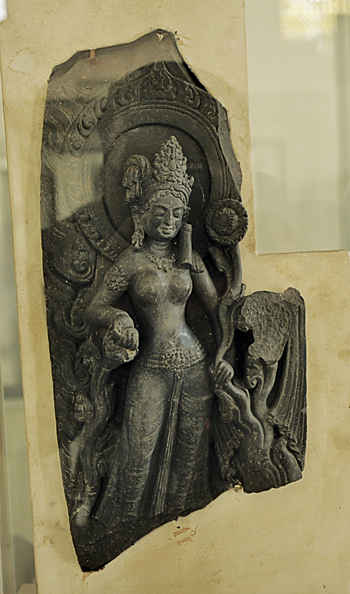Be sure you clean and decorate your home meticulously this year, as it is widely known that the goddess is easily pleased by those who venerate her, granting them fortune and bounty and a life of comfort and prosperity!
 As the season gears up for the celebration of the festival of lights, traditionally known as Tihar in Nepali, and Sunti in Nepalbhasa, people begin to clean their homes and decorate them with garlands of marigold flowers and traditional oil lamps, and in present times, with colorful flashing electric lights, in preparation of the veneration of Laxmi, the goddess of wealth.
As the season gears up for the celebration of the festival of lights, traditionally known as Tihar in Nepali, and Sunti in Nepalbhasa, people begin to clean their homes and decorate them with garlands of marigold flowers and traditional oil lamps, and in present times, with colorful flashing electric lights, in preparation of the veneration of Laxmi, the goddess of wealth.
Lakshmi is the mother-goddess who nurtures and nourishes all life, and is often associated with Lord Vishnu. A day dedicated to her worship, Lakshmi Puja, falls on the third day of Tihar, a festival joyously celebrated by all Nepali Hindus. Besides Tihar, Goddess Lakshmi is also worshipped on Kojagrata Purnima, the last day of Dasain, as Mahalakshmi.
Popularly known as the consort of Lord Visnhu, preserver of the universe, various religious texts offer different narratives regarding her origin. She is aid to have been born with auspicious features and great beauty in the hut of Sage Brigu and Khyati, and also from the body of Lord Vishnu as the other half (ardhangani). However, the most popular narrative is mentioned in the Samudra manthan chapter of Bhagwata purana (puranas are a body of ancient Sanskrit texts), where the goddess is known to have emerged during the churning of the k??ras?gara, or “Ocean of Milk”.
Regarded as the deity of abundance, wealth, prosperity, and beauty, she is worshipped in the form of paintings or sculptures as a single deity, as well as with her consort Vishnu. The Amarkosh mentions various names, Sri, Padmalaya, Padma, Kamala, Haripriya, Lokmata, Maa, Rama, in total, 11 names. Other puranas mention Lakshmi as having superior status over the other consort, Shakti, of Lord Vishnu.
The iconographic features for the making of the goddess are dictated by various religious texts that provide detailed iconographic as well as iconometric descriptions of the entire pantheon of Hindu deities and the process of their making. According to these texts, the deitiy of abundance, bounty, and fortune is portrayed either as a singular idol, or with Goddess Saraswati and Lord Ganesha, with Lord Vishnu and his consort, Garuda, popularly known as Sridhar Vishnu, and as Gajalakshmi, with two elephants offering water from pots.
The most popular book of Hindu iconography, the Vishnudhamottar Purana, describes the goddess to be fair complexioned, four-armed, carrying the ratna-patra (vessel filled with gems), sasya-patra (vessel filled with vegetables), oshadhi-patra (vessel filled with medicinal herbs), and a lotus. She should be seated on the back of four diggajas, or elephants, facing four cardinal directions. This depiction personifies her as the provider of abundance
and fortune.
Another popular Sanskrit text, Silparatna, describes her as white complexioned, holding a long stalked lotus and the bilva (bel) fruit with her right hands, and her left hands holding the amritaghata (pot containing the ambrosia) and the shankha (conch shell). Two elephants bathe her with water from either side. She is adorned with a pearl necklace, and various other jewelry on her arms, neck, waist, and hands, attended by two maidens waving the chamara (flywhisk) near her. The book also mentions her as having two arms when placed with Lord Vishnu, and four arms when portrayed singly, seated on an eight- petaled lotus placed upon a simhaasana (her vehicle, the lion).
She is usually positioned either seated singly on a lotus pedestal, standing with Lord Vishnu on the right. Small portrayals of the goddess also accompany various incarnations of Lord Vishnu. She is prominently placed at the feet of the reclining Vishnu in the form of Jalasayan Vishnu at Budanilkantha, engraved on the Vishwarupa idols, in form of the ardhanareswari, or the one half in the idol of Vishnu, and on the left side of the Harihara idol, the compound idol of Lord Vishnu and Shiva.
In Nepal, the idols of Lakshmi date back to the first century, excavated from Tilaurakot and Hadigaon, made of terracotta. Scholars date the Gajalakshmi at Patan Chyasalhiti, to the first century, according to its features. However, the best and most renowned stone idol in Nepal is that of Padmahasta Lakshmi at the National Museum, holding a lotus flower, and adorned with intricately carved crown, necklace, armlet, bangles, and waistband.
Be sure you clean and decorate your home meticulously this year, as it is widely known that the goddess is easily pleased by those who venerate her, granting them fortune and bounty and a life of comfort and prosperity!
Swosti Rajbhandari Kayastha
The author is a scholar of Nepali culture, with special interest in art and iconography. She can be reached at swostirjb@gmail.com










